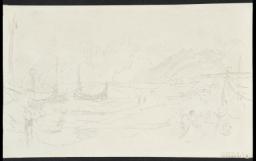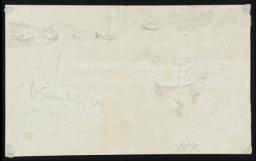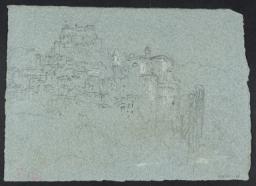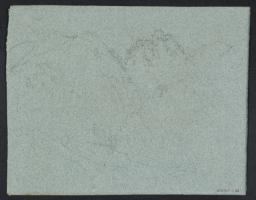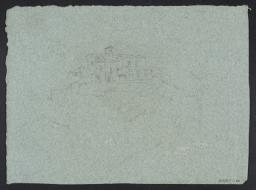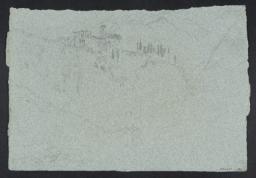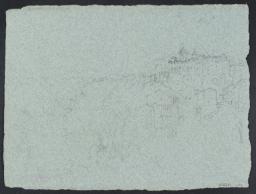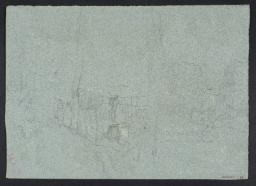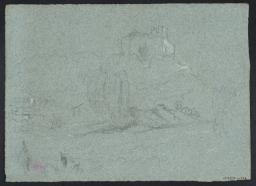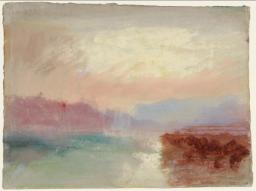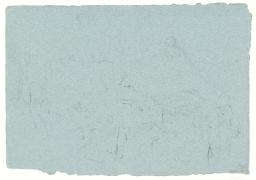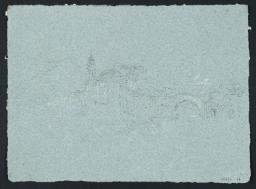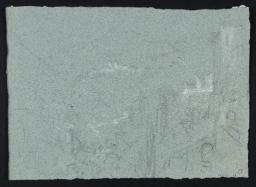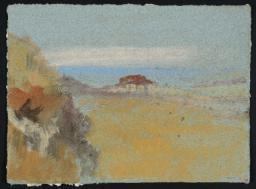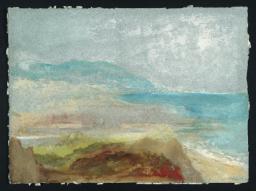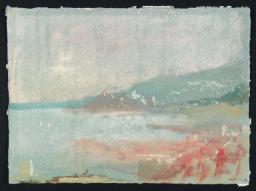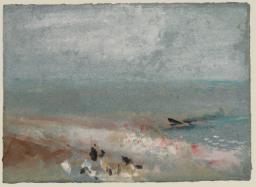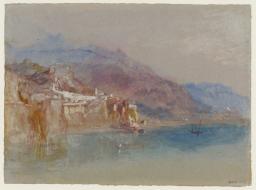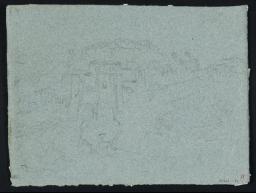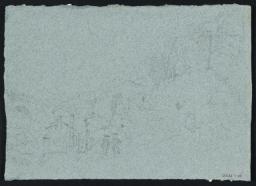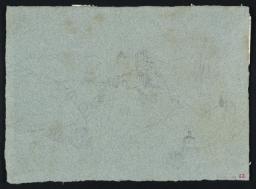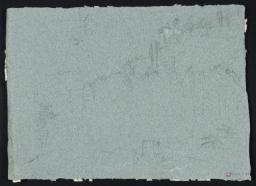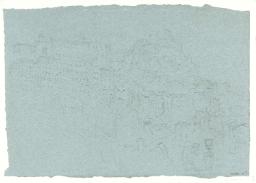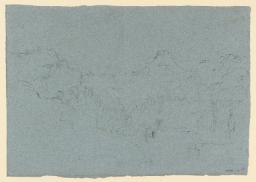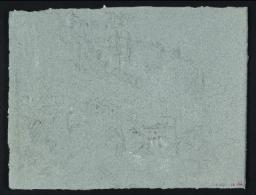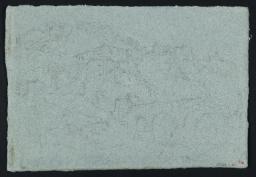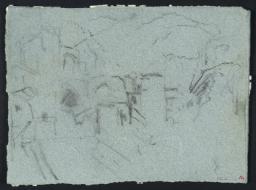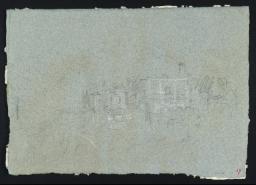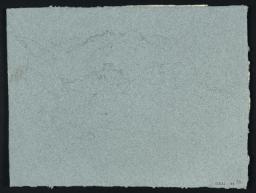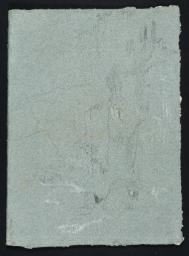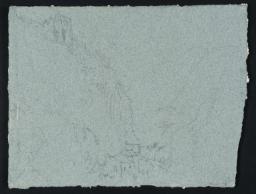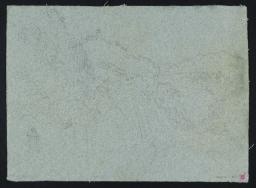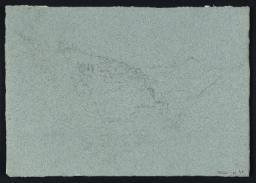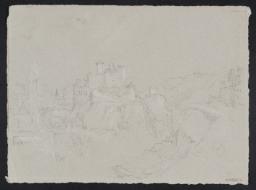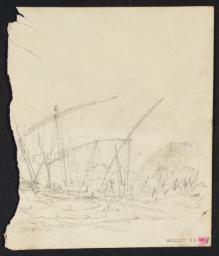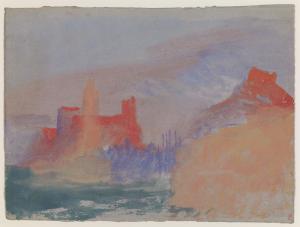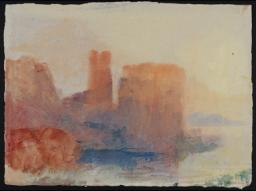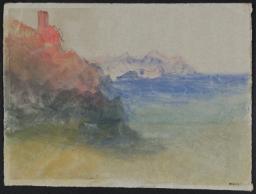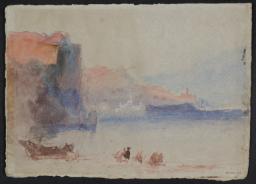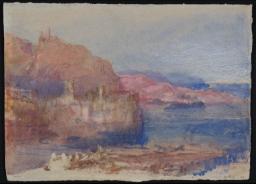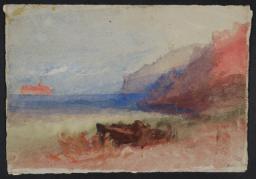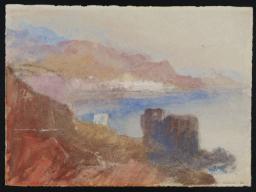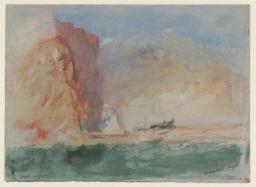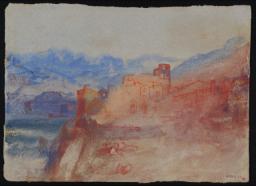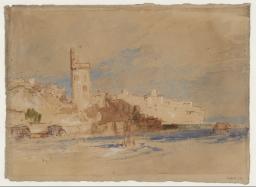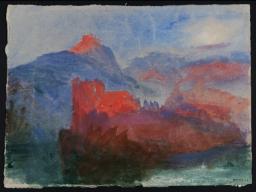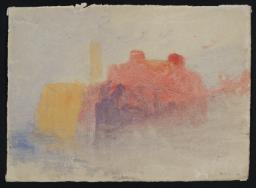From the entry
This section comprises depictions of hill towns, wooded scenery, and rocky coastal terrain worked up by Turner in various combinations of pencil, chalk, watercolour and gouache on loose sheets of white, blue, buff and grey paper. The dating of these works mostly follows that provided in A.J. Finberg’s 1909 Inventory of the Turner Bequest based on stylistic factors, although these have been updated wherever more recent assessments have been ventured. These dates span from the second half of the 1820s to the turn of the 1840s. The sketches and colour studies included in this section lack definite or recognisable landmarks, which has led to a good deal of uncertainty regarding the particular tours or working projects with which they may have been connected. Finberg included the majority of these sheets in long listings based on size, media, and estimated date, with only tentative guesses about the locations of the scenes depicted. The pencil works on blue paper included here, for example, were catalogued in a group ...
D20381, D20382, D20386, D20389, D20391, D20422, D20450, D20451, D24598, D24599, D24607, D24614, D24827, D24979, D24980, D24984, D24986–D24989, D24996–D24998, D25002–D25004, D25012–D25014, D25020, D25025, D25102, D25115, D25118, D25120, D25521, D28954, D28958, D28962, D28964, D28965, D28977, D28978, D28980, D28989, D29001, D29003, D29018, D29019, D29022, D29030, D33676, D34052, D34053, D34603, D35870, D35871, D40312
Turner Bequest CCXXIV 85, 86, 90, 93, 95, 123, 148, 149, CCLIX 33, 34, 42, 49, 262, CCLXI 7, 8, 12, 14–17, 24–26, 30–32, 40–42, 48, 53, CCLXII 2, 15, 18, 20, CCLXIII a 6, a 6 a, CCXCII 7, 11, 15, 17, 18, 30, 31, 33, 42, 52, 54, 67, 68, 71, 79, CCCXLI 1, 332, 333, CCCXLIV 201, CCCLXIV 32, 32v
Turner Bequest CCXXIV 85, 86, 90, 93, 95, 123, 148, 149, CCLIX 33, 34, 42, 49, 262, CCLXI 7, 8, 12, 14–17, 24–26, 30–32, 40–42, 48, 53, CCLXII 2, 15, 18, 20, CCLXIII a 6, a 6 a, CCXCII 7, 11, 15, 17, 18, 30, 31, 33, 42, 52, 54, 67, 68, 71, 79, CCCXLI 1, 332, 333, CCCXLIV 201, CCCLXIV 32, 32v
References
This section comprises depictions of hill towns, wooded scenery, and rocky coastal terrain worked up by Turner in various combinations of pencil, chalk, watercolour and gouache on loose sheets of white, blue, buff and grey paper. The dating of these works mostly follows that provided in A.J. Finberg’s 1909 Inventory of the Turner Bequest based on stylistic factors, although these have been updated wherever more recent assessments have been ventured.1 These dates span from the second half of the 1820s to the turn of the 1840s.
The sketches and colour studies included in this section lack definite or recognisable landmarks, which has led to a good deal of uncertainty regarding the particular tours or working projects with which they may have been connected. Finberg included the majority of these sheets in long listings based on size, media, and estimated date, with only tentative guesses about the locations of the scenes depicted. The pencil works on blue paper included here, for example, were catalogued in a group wherein the subjects were ‘connected with the Meuse Mosel Tour’, although Finberg believed that some of the works belonged ‘to the ‘Rivers of France’ series, or even the Italian tour of 1828’.2 More recent scholarship has also found this material perplexing in terms of date and subject matter. Thus in the 1987 edition of Andrew Wilson’s Turner in his Time, the sheetD29018 (Turner Bequest CCXCII 67) was reproduced as a view of the Meuse or Mosel River, although this was subsequently described less specifically as a ‘sketch’ for the ‘Great Rivers of Europe’ project in the revised 2006 edition.3 In 1975, Gerald Wilkinson questioned whether colour studies such as D29019 (Turner Bequest CCXCII 68) had any topographical content at all, and should rather, perhaps, be regarded as trials for particularly ‘brilliant colour schemes’.4
The highly tentative grouping presented here, which connects this material to Turner’s various tours of the South of France and Italy between 1819 and 1833,5 is based on style and subject matter. In the case of the colour studies, the starting point is Ian Warrell’s observation that the South of France in high summer prompted Turner to adopt a ‘vivid and often unusual’ palette that is ‘rich in pinks, lilacs, vermillions and ochres’.6 Warrell’s example of this kind of picture is the watercolour D29022 (Turner Bequest CCXCII 71), and other sheets are included in this section based on comparable colour combinations. As a note of caution, however, it should be pointed out that Warrell has also detected the use of this palette in the depiction of the Channel port of France. In 1997, for instance, he thought it possible that D24614 (Turner Bequest CCLIX 49) is a depiction of the Normandy town of Cherbourg rather than a more southern location.7
The other main criterion for inclusion in this section is the depiction of rocky landscapes, more often than not occupied by dense clusters of flat-roofed buildings that climb steeply up hilltops or descend steeply down to the seashore. Such vistas are particularly abundant around the coastal and mountainous regions of the South of France and Italy, through which Turner passed in 1819–20 (Lombardy, Tuscany, the Campagna, Amalfi coast), 1828 (South of France, Ligurian Coast), 1833 (Italian Alps). Although these works are grouped together here in a tentative fashion, it is hoped that this cataloguing exercise will facilitate future attempts at connecting the material more firmly to Turner’s other activities.
Andrew Wilton, Turner in his Time, London 1987, p.134; Andrew Wilton, Turner in his Time, revised ed., London 2006, p.155.
Ian Warrell, ‘France’ in Evelyn Joll, Martin Butlin and Luke Herrmann eds., The Oxford Companion to J.M.W. Turner, Oxford 2001, pp.114–15; Cecilia Powell, ‘Italy’ in ibid., pp.150–52.
How to cite
John Chu, ‘?South of France and Italy c.1820–41’, June 2015, in David Blayney Brown (ed.), J.M.W. Turner: Sketchbooks, Drawings and Watercolours, Tate Research Publication, November 2016, https://www


